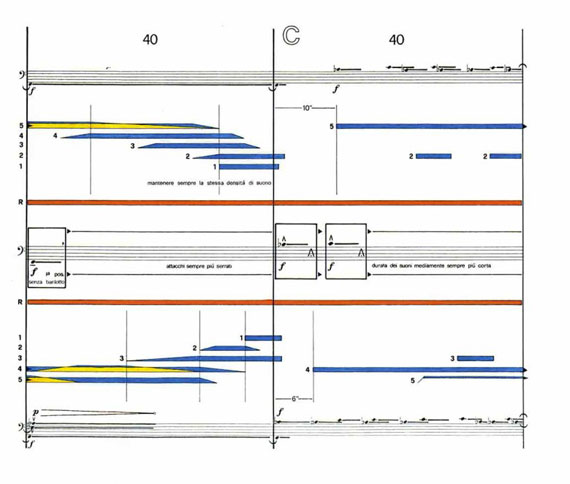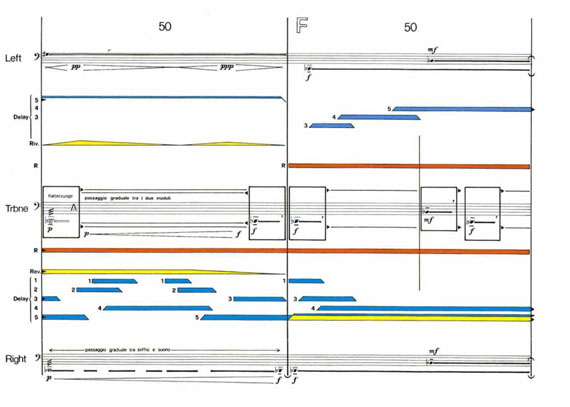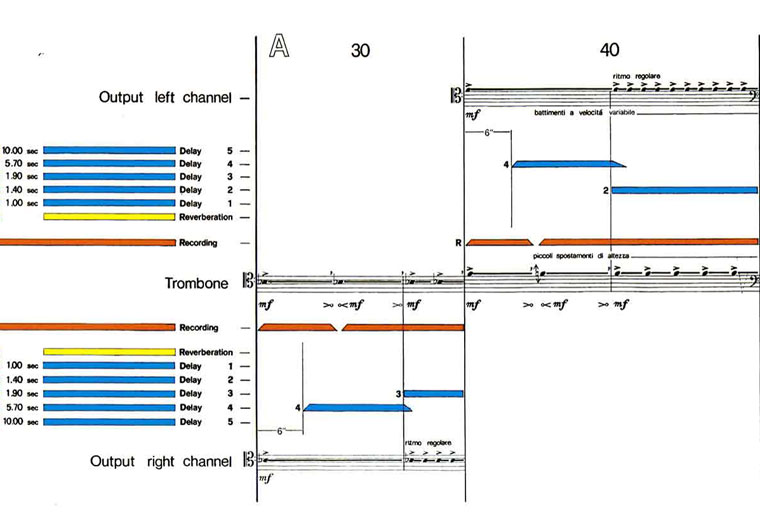edizioni Edipan
1st performance – October 25, 1983 – Roma, Festival di Nuova Consonanza, National Institute of Architecture
trombone – Renzo Brocculi
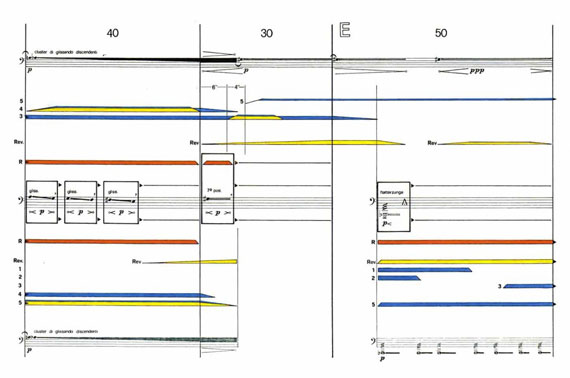
“Give me a trombone and I will lift the world”: it could be the theme song of Luigi Ceccarelli, composer fruitfully attentive to electroacoustic research, who broke the beautiful walls and the beautiful ceiling of the hall of Palazzo Taverna (third concert of Nuova Consonanza), leaving the public in the open, in a mysterious open space, lost in the cosmos. The phenomenon – that is, this astounding ability of sound to grow into a sort of phonic, chaining and enveloping cloud – lasted for about twenty minutes, achieving unprecedented results.
… Luigi Ceccarelli entitles this electroacoustic evocation entrusted to the trombone “Encounter with Rama”, disclosing biblical evocations (“A voice is heard from Rama / human lament and cry / Rachel weeps for her children ….), but also overshadowing Indian mythology. sound involves, who knows, the hero Rama, in which a reincarnation of Vishnu is celebrated.
Erasmo Valente – L’Unità – 10/27/1983
The novel by A. C. Clarke “Rendezvous with Rama”, from which this work takes its cue, is an exciting story of exploration of a future world, a spaceship-planet that came near the earth from the depths of the cosmos. A complex and wonderful mechanism, a perfect planet-machine built for the maintenance of a biological life where machines are at the service of nature.
In the same way, this “Encounter with Rama” tells the exploration of a sound universe managed by two machines, one very old and one technologically very advanced: it is a trombone, one of the oldest instruments built by mankind, and a electroacoustic sound delay device made by computer.
The two machines interpenetrate in perfect symbiosis; the two performers (the trombonist and the electronic operator), without being tied to a predefined timing, react one to the other’s sound stimuli giving life to a single sound body. The meaning of “Encounter with Rama”, however, should not be sought in the technique but in the more atavistic and primordial dimension that the sound of the trombone can evoke.
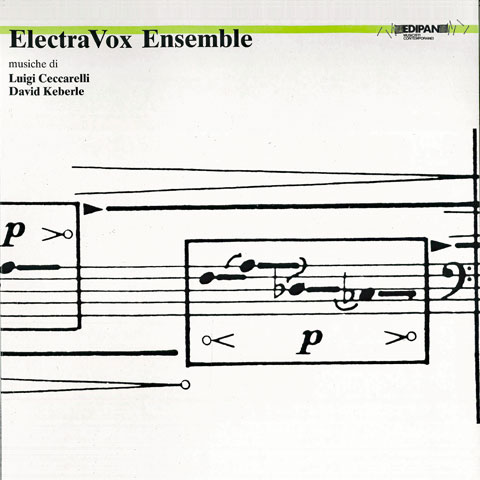
Incontro con Rama is included in LP
LP – Electravox Ensemble I (1986)
Renzo Brocculi trombone
Luigi Ceccarelli – feedback device
duration 18′
LP Edipan PAN PRC S20 – 3
Buy LP Online
performances of Incontro con Rama
Apr 28, 83 – Cosenza, Teatro Rendano
Oct 25, 83 – Roma, Nuova Consonanza, Istit. Naz. di Architettura
Nov 05, 84 – Porto Alegre (Bra), Teatro S.Pedro
Nov 08 , 84 – Montevideo, Istituto Anglo-Uruguajo.
Nov 14, 84 – Buenos Aires, Centro Cultural S.Martin
Jun 14, 85 – Roma, Festival di Villa Medici, Accademia di Francia
Jul 20, 85 – Città della Pieve
Oct 20, 86 – Faenza, Interpreti della Nuova Musica, sala Dante
Jun 11, 87 – Cosenza, Università della Calabria
May 18- 21 , 89 – Narni, Scenari dell’Immateriale
Sep 26, 89 – L’Aquila, “Performing Music”, Teatro S. Filippo
Dec 10, 95 – Roma, Air Terminal Ostiense, Progetto Musica ’95
Aug 21, 2016 – Vitllyke (Sweden), Centre for the Performing Arts – Trb Ivo Nilsson
“Incontro con Rama” was created for the first time in 1982 after a work of absolute complementarity between the indications, the aspirations of Luigi Ceccarelli and the technical practice of Renzo Brocculi: a splendid creature generated in a single week of close commitment made with two trombones, a tuba and a complex electronic device for the delay and accumulation of sounds, built by the author precisely to carry out this work.
The writing of this work moves on two main tracks: on the one hand the preference for the timbre dimension and spectral micro-variations, on the other the almost complete absence of melody, in the usual sense of the term. The reference to the rhythm of breathing, as an alternative to heart rhythm (which music usually favors), however, is the only supporting basis of all the architecture on which this piece is conceived.
Certainly these we have mentioned are rules that refer more to oriental concepts of sound than to those of our music: in “Encounter with Rama” we can clearly recognize “OM”, the fundamental sound generating the universe according to Indian mythology. Indeed, we can certainly say that “Encounter with Rama” is nothing other than “OM” in its purest essence.
To listen to this music it is necessary to overcome the apparent fixity of the sound, and to enter the sound itself to discover its extreme complexity and continuous variability. In this way it will be possible to perceive with a newfound concentration of listening the universality that translates from the breath of the trombonist: an evident reference to the primitive cosmicity of the breath.
Here, then, that the fixity of the atmospheres will serve to better perceive the complex timbral stratification that takes place between the live trombone voice and this same voice delayed and superimposed on itself through the processor. The result of this “Incontro con Rama” is a work of sonic charm, where finally, the acoustic research is happily combined with that of the universality of hearing.
